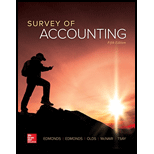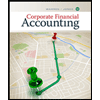
Louise Stinson, the chief financial officer of Bostonian Corporation, was on her way to the president’s office. She was carrying the latest round of bad news. There would be no executive bonuses this year. Corporate profits were down. Indeed, if the latest projections held true, the company would report a small loss on the year-end income statement. Executive bonuses were tied to corporate profits. The executive compensation plan provided for 10 percent of net earnings to be set aside for bonuses. No profits meant no bonuses. While things looked bleak, Stinson had a plan that might help soften the blow.
After informing the company president of the earnings
Some of the other items that Stinson is considering include (1) converting from straight-line to accelerated depreciation, (2) increasing the percentage of receivables estimated to be uncollectible in the current year and lowering the percentage in the following year, and (3) raising the percentage of estimated warranty claims in the current period and lowering it in the following period. Finally, Stinson notes that two of the company’s department stores have been experiencing losses. The company could sell these stores this year and thereby improve earnings next year. Stinson admits that the sale would result in significant losses this year, but she smiles as she thinks of next year’s bonus check.
Required
- a. Explain how each of the three numbered strategies for increasing the amount of the current year's loss would affect the stockholders’ equity section of the
balance sheet in the current year. How would the other elements of the balance sheet be affected? - b. If Stinson's strategy were effectively implemented, how would it affect the stockholders’ equity in subsequent accounting periods?
- c. Comment on the ethical implications of running the company for the sake of management (maximization of bonuses) versus the maximization of return to stockholders.
- d. Formulate a bonus plan that will motivate managers to maximize the value of the firm instead of motivating them to manipulate the reporting process.
- e. How would Stinson's strategy of overstating the amount of the reported loss in the current year affect the company’s current P/E ratio?
Want to see the full answer?
Check out a sample textbook solution
Chapter 8 Solutions
Survey Of Accounting
- Ethics and professional conduct in business Tonya Latirno is a certified public accountant (CPA) and staff accountant for Kennedy and Kennedy, a local CPA firm. It had been the policy of the firm to provide a holiday bonus equal to two weeks salary to all employees. The firms new management team announced on November 15 that a bonus equal to only one weeks salary would be made available to employees this year. Tonya thought that this policy was unfair because she and her co- workers planned on the full two-week bonus. The two-week bonus had been given for 10 straight years, so it seemed as though the- firm had breached an implied commitment. Thus, Tonya decided that she would make up the lost bonus week by working an extra six hours of overtime per week over the next five weeks until the end of the year. Kennedy and Kennedys policy is to pay overtime at 150% of straight time. Tonyas supervisor was surprised to see overtime being reported, because there is generally very little additional or unusual client service demands at the end of the calendar year. However, the overtime was not questioned, because firm employees are on the honor system in reporting their overtime. Discuss whether the firm is acting in an ethical manner by changing the bonus. Is Tonya behaving in an ethical manner?arrow_forwardEthics and professional conduct in business Tonya Latirno is a certified public accountant (CPA) and staff accountant for Kennedy and Kennedy, a local CPA firm. It had been the policy of the firm to provide a holiday bonus equal to two weeks salary to all employees. The firms new management team announced on November 15 that a bonus equal to only one weeks salary would be made available to employees this year. Tonya thought that this policy was unfair because she and her coworkers planned on the full two-week bonus. The two-week bonus had been given for 10 straight years, so it seemed as though the firm had breached an implied commitment. Thus, Tonya decided that she would make up the lost bonus week by working an extra six hours of overtime per week over the next five weeks until the end of the year. Kennedy and Kennedys policy is to pay overtime at 150% of straight time. Tonyas supervisor was surprised to see overtime being reported, because there is generally very little additional or unusual client service demands at the end of the calendar year. However, the overtime was not questioned, because firm employees are on the honor system in reporting their overtime. Discuss whether the firm is acting in an ethical manner by changing the bonus. Is Tonya behaving in an ethical manner?arrow_forwardEthics and professional conduct in business The director of marketing for Truss Industries Inc.. Ellen Knutson, had the following discussion with the company controller. Bud Wyckoff. on February 26 of the current year: Ellen: Bud, it looks like I'm going to spend much less than indicated on my February budget. Butt: I'm glad to hear it. Ellen: Well. I'm not so sure it's good news. I'm concerned that the president will see that I'm under budget and reduce my budget in the future. The only reason that I look good is that we've delayed an advertising campaign. Once the campaign hits in May. I'm sure my actual expenditures will go up. You see. we are also having our sales convention in May. Having the advertising campaign and the convention at the same time is going to kill my May numbers.arrow_forward
- Ethics Case 19-12 International Network Solutions LO19-6 International Network Solutions provides products and services related to remote access networking. The com- pany has grown rapidly during its first 10 years of operations. As its segment of the industry has begun to mature, though, the fast growth of previous years has begun to slow. In fact, this year revenues and profits are roughly the same as last year. One morning, nine weeks before the close of the fiscal year, Rob Mashburn, CFO, and Jessica Lane, controller, were sharing coffee and ideas in Lane's office. Y Lane: Mashburn: Lane: Mashburn: About the Board meeting Thursday. You may be right. This may be the time to suggest a share buyback program. To begin this year, you mean? Right! I know Barber will be lobbying to use the funds for our European expansion. She's probably right about the best use of our funds, but we can always issue more notes next 。 year. Right now, we need a quick fix for our EPS numbers. Our…arrow_forwardSolve the Dilemma LO 14-6 Assess a company's financial position using its accounting statements and ratio analysis. Exploring the Secrets of Accounting You have just been promoted from vice president of marketing of BrainDrain Corporation to president and CEO! That's the good news. Unfortunately, while you know marketing like the back of your hand, you know next to nothing about finance. Worse still, the "word on the street" is that BrainDrain is in danger of failure if steps to correct large and continuing financial losses are not taken immediately. Accordingly, you have asked the vice president of finance and accounting for a complete set of accounting statements detailing the financial operations of the company over the past several years. Recovering from the dual shocks of your promotion and feeling the weight of the firm's complete accounting report for the very first time, you decide to attack the problem systematically and learn the "hidden secrets" of the company, statement by…arrow_forwardPROBLEM 16-8 Discussion Case with Ethical Issue Alan Norwood is currently a senior associate with the law firm of Butler, Starns, and Madden (BSM). His compensation currently includes a salary of $155,000, and benefits valued at $5,000. BSM is considered among the strongest of local firms, with assets of $10 million (cash $2,000,000, and accounts receivables $8,000,000), liabilities of $7.5 million, and 11 partners. Alan anticipates admission to the partnership on July 1 of this year. The senior managing partner, Jane Butler, has had preliminary discussions with Alan in which the senior partner proposed the following 1. A5% interest in BSM capital and profits in recognition of Alan's commitment to the firm and in exchange for a capital investment by Alan of $150,000. This 5% interest would be acquired from the other partners. 2. Alan's compensation will consist of a monthly withdrawal of $18,000 and benefits valued at $5,000 annually. Monthly withdrawals approximate firm profits, but…arrow_forward
- The cloudy afternoon mirrored the mood of the conference of division managers. Claude Meyer, assistant to thecontroller for Hunt Manufacturing, wore one of the gloomy faces that were just emerging from the conferenceroom. “Wow, I knew it was bad, but not that bad,” Claude thought to himself. “I don’t look forward to sharingthose numbers with shareholders.”The numbers he discussed with himself were fourth-quarter losses which more than offset the profits of the firstthree quarters. Everyone had known for some time that poor sales forecasts and production delays had wreakedhavoc on the bottom line, but most were caught off guard by the severity of damage.Later that night he sat alone in his office, scanning and rescanning the preliminary financial statements on hiscomputer monitor. Suddenly his mood brightened. “This may work,” he said aloud, though no one could hear.Fifteen minutes later he congratulated himself, “Yes!”The next day he eagerly explained his plan to Susan Barr, controller…arrow_forwardProblem 19.9 Cattail Corporation's financial statements for the fiscal year just ended are shown below: Cattail Corporation Financial Statements for Fiscal Year Just Ended ($ thousands) Income Statement Balance Sheet Net sales $1,400 Assets $730 Debt $600 Costs 350 Equity $130 Net income $1,050 Total $730 Total $730 Cattail management expects sales to increase by 14 percent next year. Assume that the financial statement accounts vary directly with changes in sales and that management has no financing plan at this time. Given this information, develop a pro forma income statement for Cattail for the next fiscal year. Cattail Corporation Pro Forma Income Statement ($ thousands)arrow_forwardQuestion Two Risk in the widest sense is not new to business. All companies are exposed to traditional business risks: earmings go up and down as a result of such things as changes in the business environment, in the nature of competition, in production technologies, and in factors affecting suppliers. The issue of risk has captured considerable attention from corporate management in recent years, as financial risk management has become a critical corporate activity. Regulators have also responded with new legislation, regulations, and practices that seek to improve corporate govemance standards. Required: Some in the academic world contend that corporate risk management is a zero-sum game. Discuss.arrow_forward
 Financial & Managerial AccountingAccountingISBN:9781337119207Author:Carl Warren, James M. Reeve, Jonathan DuchacPublisher:Cengage Learning
Financial & Managerial AccountingAccountingISBN:9781337119207Author:Carl Warren, James M. Reeve, Jonathan DuchacPublisher:Cengage Learning Accounting (Text Only)AccountingISBN:9781285743615Author:Carl Warren, James M. Reeve, Jonathan DuchacPublisher:Cengage Learning
Accounting (Text Only)AccountingISBN:9781285743615Author:Carl Warren, James M. Reeve, Jonathan DuchacPublisher:Cengage Learning Survey of Accounting (Accounting I)AccountingISBN:9781305961883Author:Carl WarrenPublisher:Cengage Learning
Survey of Accounting (Accounting I)AccountingISBN:9781305961883Author:Carl WarrenPublisher:Cengage Learning Financial & Managerial AccountingAccountingISBN:9781285866307Author:Carl Warren, James M. Reeve, Jonathan DuchacPublisher:Cengage Learning
Financial & Managerial AccountingAccountingISBN:9781285866307Author:Carl Warren, James M. Reeve, Jonathan DuchacPublisher:Cengage Learning Corporate Financial AccountingAccountingISBN:9781337398169Author:Carl Warren, Jeff JonesPublisher:Cengage Learning
Corporate Financial AccountingAccountingISBN:9781337398169Author:Carl Warren, Jeff JonesPublisher:Cengage Learning AccountingAccountingISBN:9781337272094Author:WARREN, Carl S., Reeve, James M., Duchac, Jonathan E.Publisher:Cengage Learning,
AccountingAccountingISBN:9781337272094Author:WARREN, Carl S., Reeve, James M., Duchac, Jonathan E.Publisher:Cengage Learning,





